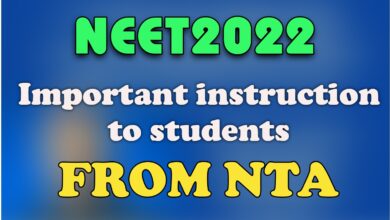NEET BIOLOGY : PLUS TWO SYLLABUS
BIOLOGY: CONTENTS OF CLASS XII SYLLABUS
UNIT I: Reproduction
• Reproduction in organisms: Reproduction, a characteristic feature of all organisms for
continuation of species; Modes of reproduction – Asexual and sexual; Asexual reproduction;
Modes-Binary fission, sporulation, budding, gemmule, fragmentation; vegetative propagation in
plants.
• Sexual reproduction in flowering plants: Flower structure; Development of male and female
gametophytes; Pollination-types, agencies and examples; Outbreeding devices; Pollen-Pistil
interaction; Double fertilization; Post fertilization events- Development of endosperm and
embryo, Development of seed and formation of fruit; Special modes-apomixis, parthenocarpy,
polyembryony; Significance of seed and fruit formation.
• Human Reproduction: Male and female reproductive systems; Microscopic anatomy of testis and
ovary; Gametogenesis-spermatogenesis & oogenesis; Menstrual cycle; Fertilisation, embryo
development upto blastocyst formation, implantation; Pregnancy and placenta formation
(Elementary idea); Parturition (Elementary idea); Lactation (Elementary idea).
• Reproductive health: Need for reproductive health and prevention of sexually transmitted diseases
(STD); Birth control-Need and Methods, Contraception and Medical Termination of Pregnancy
(MTP); Amniocentesis; Infertility and assisted reproductive technologies – IVF, ZIFT, GIFT
(Elementary idea for general awareness).
UNIT II: Genetics and Evolution
• Heredity and variation: Mendelian Inheritance; Deviations from Mendelism- Incomplete
dominance, Co-dominance, Multiple alleles and Inheritance of blood groups, Pleiotropy;
Elementary idea of polygenic inheritance; Chromosome theory of inheritance; Chromosomes and
genes; Sex determination-In humans, birds, honey bee; Linkage and crossing over; Sex linked
inheritance-Haemophilia, Colour blindness; Mendelian disorders in humans-Thalassemia;
Chromosomal disorders in humans; Down’s syndrome, Turner’s and Klinefelter’s syndromes.
• Molecular basis of Inheritance: Search for genetic material and DNA as genetic material; Structure
of DNA and RNA; DNA packaging; DNA replication; Central dogma; Transcription, genetic
code, translation; Gene expression and regulation- Lac Operon; Genome and human genome
project; DNA finger printing.
• Evolution: Origin of life; Biological evolution and evidences for biological evolution from
Paleontology, comparative anatomy, embryology and molecular evidence); Darwin’s
contribution, Modern Synthetic theory of Evolution; Mechanism of evolution-Variation (Mutation
and Recombination) and Natural Selection with examples, types of natural selection; Gene flow
and genetic drift; Hardy-Weinberg’s principle; Adaptive Radiation; Human evolution.
UNIT III: Biology and Human Welfare
• Health and Disease; Pathogens; parasites causing human diseases (Malaria, Filariasis, Ascariasis.
Typhoid, Pneumonia, common cold, amoebiasis, ring worm); Basic concepts of immunology-
vaccines; Cancer, HIV and AIDS; Adolescence, drug and alcohol abuse.
Improvement in food production; Plant breeding, tissue culture, single cell protein,
Biofortification; Apiculture and Animal husbandry.
• Microbes in human welfare: In household food processing, industrial production, sewage
treatment, energy generation and as biocontrol agents and biofertilizers.
UNIT IV: Biotechnology and Its Applications
• Principles and process of Biotechnology: Genetic engineering (Recombinant DNA technology).
• Application of Biotechnology in health and agriculture: Human insulin and vaccine production,
gene therapy; Genetically modified organisms-Bt crops; Transgenic Animals; Biosafety issues-
Biopiracy and patents.
UNIT V: Ecology and Environment
• Organisms and environment: Habitat and niche; Population and ecological adaptations; Population
interactions-mutualism, competition, predation, parasitism; Population attributes-growth, birth
rate and death rate, age distribution.
• Ecosystem: Patterns, components; productivity and decomposition; Energy flow; Pyramids of
number, biomass, energy; Nutrient cycling (carbon and phosphorous); Ecological succession;
Ecological Services-Carbon fixation, pollination, oxygen release.
• Biodiversity and its conservation: Concept of Biodiversity; Patterns of Biodiversity; Importance
of Biodiversity; Loss of Biodiversity; Biodiversity conservation; Hotspots, endangered organisms,
extinction, Red Data Book, biosphere reserves, National parks and sanctuaries.
• Environmental issues: Air pollution and its control; Water pollution and its control; Agrochemicals
and their effects; Solid waste management; Radioactive waste management; Greenhouse effect
and global warning; Ozone depletion; Deforestation; Any three case studies as success stories
addressing environmental issues.
